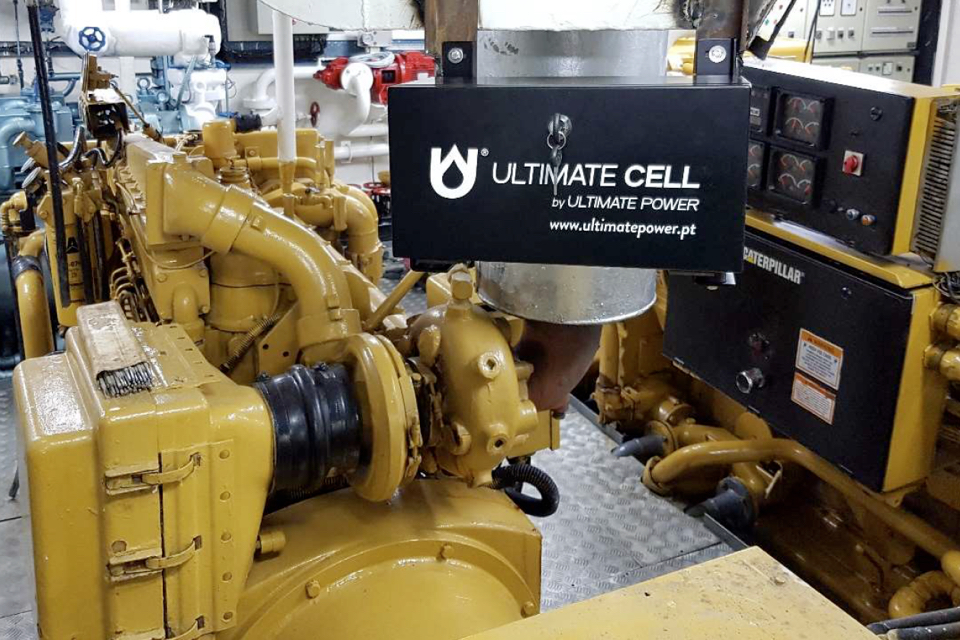As a pilot, a barge in Rotterdam will be equipped with Ultimate Cell technology. This system injects hydrogen gas into the engine to improve combustion. According to the company behind the system, this process can cut harmful emissions by up to 80 per cent.
When the engine starts, Ultimate Cell initiates an electronically controlled electrolysis process, resulting in the chemical separation of the hydrogen molecules. These will subsequently be mixed with the engine’s feed-air, reaching the gas chamber, enriching the fuel mix and improving combustion. The hydrogen molecules function as a catalyst to the fuel burn and as a combustion-optimiser, and not as a fuel replacement.
The system is patented by Portuguese company Ultimate Cell LDA/Ultimate Power LDA. The optimised combustion-reaction is said to decrease fuel consumption by up to 20 per cent and exhaust emissions by up to 80 per cent and will also reduce engine contamination caused by these emissions.
No engine alterations
‘The unit is installed in the engine compartment of the vessel and powered by the 12 or 24 Volts of the vessel’s battery. It is electronically controlled and switches itself on and off,’ says the company’s representative for the Benelux Frank van der Haagen. ‘The Cell will only operate when the engine is running, thus avoiding unnecessary power consumption. When the engine starts, the Ultimate Cell initiates the electrolysis process.’
In addition, he stresses there are no alterations needed to the existing engine. ‘The settings of the existing engine remain unchanged, nor are any changes made to the engine or to the lubricating oil. The unit, which is roughly the size of a washing machine, can be installed on board within a couple of hours. It only needs to be connected to the ship’s battery and the engine’s intake.’
The design of the hydrogen-production process is also said to occur without adding significant additional electrical load on the electrical system of the vessel, nor adding notable mechanical load on the engine. The energy consumption of Ultimate Cell while operating is low and ranges from 0.08 A minimum to 0.70 A maximum, and 0.01 A on standby.
No hydrogen storage
The system does not require any storage of hydrogen. Van der Haagen: ‘Because only a minimal amount of hydrogen is required, the unit produces only those amounts of hydrogen that are required in real time by the engine. There is no interim storage, neither in the gaseous state nor in the liquid state.’
Van Der Haagen also adds that ‘in principle, the system pays for itself by saving fuel in about 6 months. The units themselves have a lifespan of about 10 years.’
Pilot coming soon
The system is now being introduced in the Netherlands for the first time for inland navigation, the towage and pusher craft sector and shipping in general. Van der Haagen: ‘The system has been in use for several years in various countries and for various applications, ranging from ships to land-based applications like cars, trucks, generators and trains. In Portugal, for example, several fishing boats and ferries have already been equipped with the system.’
A measurement campaign was conducted on board one of the catamaran ferries of the Public Ferry Company Soflusa in Lisbon. ‘Fuel consumption on board this vessel reduced by 16 per cent,’ says Van der Haagen.
Right now, Van der Haagen says the company is still completing some of the necessary documents and looking for the right type of barge of about 2/3000 tonnes to perform the pilot on, which he hopes to find within the next few weeks. He expects the pilot in Rotterdam to take place very soon after that.
Picture: Ultimate Cell installation on board a fishing boat in Morocco.








